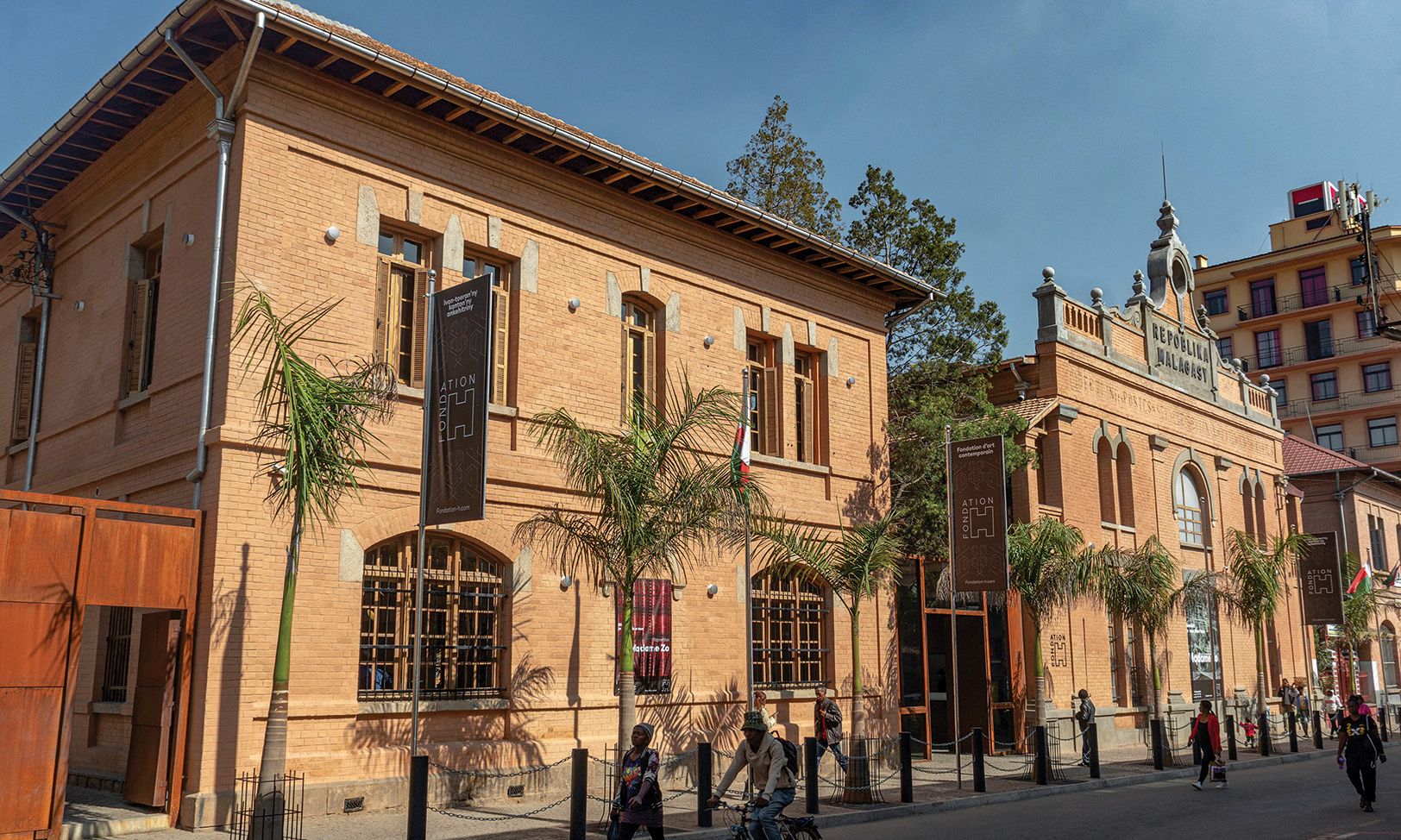Fondation H, housed in a colonial-era building restored by Architecture Otmar Dodel and offering free entry, welcomed more than 110,000 visitors during its first ten months; its current show features 22 artists from Madagascar, Africa and the African diaspora © Fondation H
Madagascar is the fourth largest island in the world—and also one of the world’s poorest countries. Its population is around 29 million, but 20 million of its citizens do not have electricity and only half have access to clean water. Three-quarters of the population live in poverty, according to the World Bank.
In view of all this, art may not seem a priority. But two local businessmen are creating an art scene, virtually from scratch. One is Hassanein Hiridjee, who opened an arts space, Fondation H, a year ago and inaugurated its second exhibition in April.
The second is Hasnaine Yavarhoussen, whose non-profit Hakanto Contemporary also supports local artists and shows the work of young emerging names in a 500 sq. m space in offices to the south of Madagascar’s capital Antananarivo, also known as Tana. This autumn Hakanto will move to a larger, purpose-built site in the centre of the town.
Both men are heirs of powerful local companies whose fortunes are built on energy, real estate, communications and other industries: Axian in the case of Hiridjee, Filatex in the case of Yavarhoussen.
Madagascar, which was a French colony until independence in 1960—has no art school nor even any museums or places to see contemporary art, although there is a small, private museum of photography in Tana. There are just a couple of art galleries in Tana, Is’Art and Flow, but it is a struggle for local artists, who often sell direct to collectors. Paritana, a prize established in 2017 by Fondation H, helps Malagasy artists; it offers financial support and a residency in Paris.
Fondation H has a small exhibition space in the French capital, but its base is a colonial-era building in Tana, elegantly restored and extended by the Malagasy architectural firm Architecture Otmar Dodel.
Built between 1912 and 1920 in ochre-coloured brick, the edifice still bears the inscription “Direction des Postes” on its exterior wall. An open courtyard, lush with tropical plants, leads into 2,200 sq. m of exhibition rooms as well as a garden. The small art library is apparently Tana’s only such space; there is also a café. Such is the success of the foundation that more than 110,000 people visited it in the first 10 months after opening: entrance is free, and open to all; on an April afternoon, there was a constant flow of visitors, mostly in their 20s.
The exhibition in Fondation H, Memoria, récits d’une autre histoire (memoria, accounts of another history; until 28 February 2025) brings together 22 artists—Malagasy, African and from the African diaspora. It is curated by Nadine Hounkpatin and Céline Seror. Works on display include videos, installations, paintings and a series of images of a disused colonial-era school by the Congolese photographer Gosette Lubondo, lent by the Parisian Musée du Quai Branly.
In view of the lack of other educational facilities for artists, Fondation H also runs free workshops, including the Ainga programme, to help artists with the practical aspects of their careers, including simplified accounting, inventory techniques, how to constitute a portfolio or apply for residencies and so on. State-certified certificates are issued at the end of the programme.
A local artist couple, Richianny Ratovo and Mat Li, have taken some of the courses. “The arrival of the two foundations certainly will lead to increased professionalisation,” Ratovo says. “Ninety percent of the artists in Madagascar are self-taught, and many don’t have representation.”
One exception is Temandrota (birth name Randriahasandratra Razafimandimby) who won the first Paritana prize in 2017 and is now represented by the London gallery 50 Golborne; his work, partly consisting of abstract painting on sisal or other natural media, will be shown at the 1-54 Contemporary African Art Fair in London in October. He recounts how he started ten years ago by exhibiting in hotels or in the French Institute; he has benefited from a number of residencies in France and South Africa.
The other foundation, Hakanto, was presenting a small exhibition of young Malagasy artists in early April; the programme is overseen by the Malagasy artist Joël Andrianomearisoa. He represented Madagascar at the 2019 Venice Biennale, thanks to Hakanto and with support from Fondation H. This year, however, the country is not represented in Venice.
As well as trying to kick-start an arts scene, both Hiridjee and Yavarhoussen, via their companies, have extensive humanitarian programmes. Filatex has implemented 32 projects in the country, while the Axian Foundation has multiple philanthropic actions and, Hiridjee says, taking just one example, has built 200 schools in co-operation with the government over the past 15 years.
Talking about the foundation, Hiridjee says: “We have great ambitions for our project; we want to make sure it is strong, it is becoming more and more active, that it is enriching its programme and reinforcing the whole art ecosystem.”
Looking around the historic building that houses it, he says: “This is what Madagascar was, and what Madagascar should become!”

